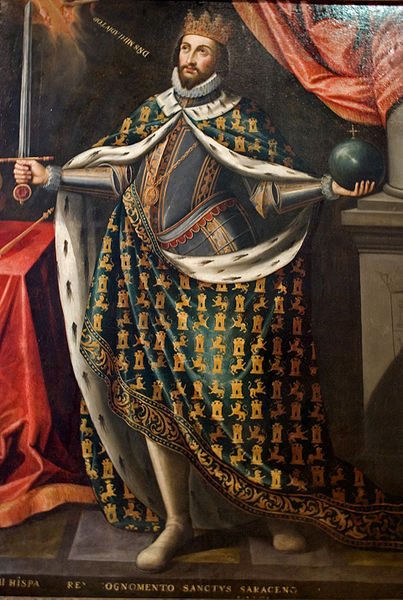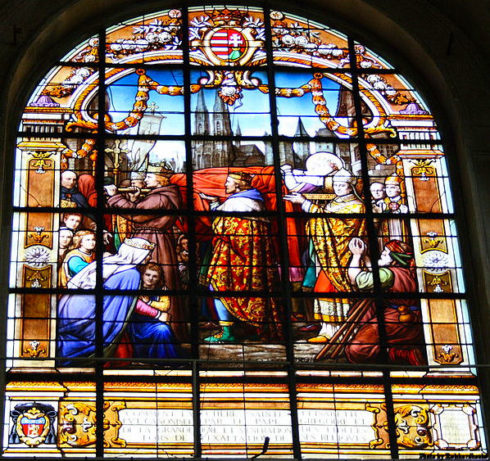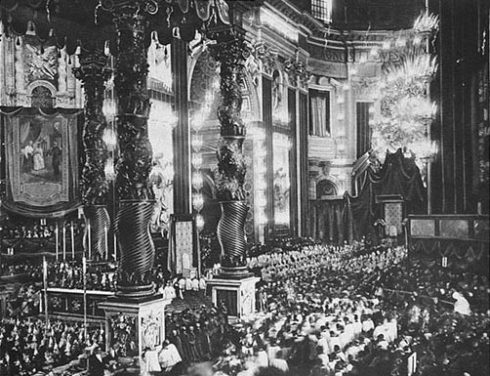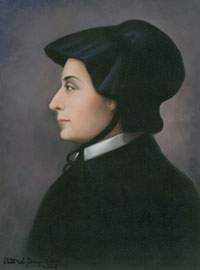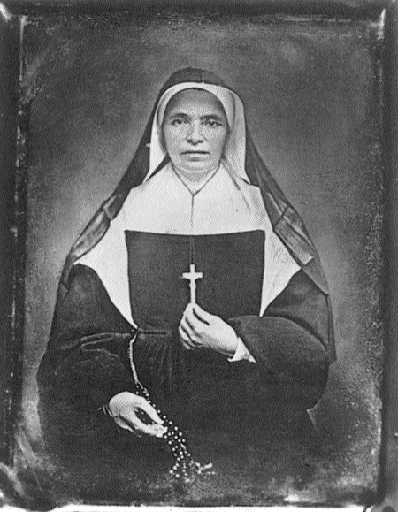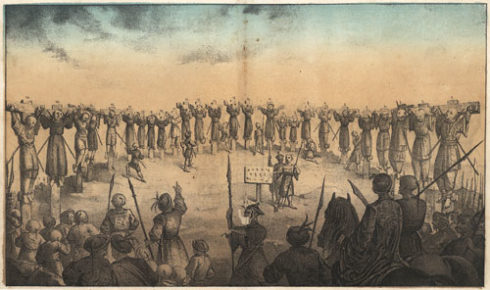All Saints’ Day: Is Being Noble and Leading a Noble’s Life Incompatible with Sanctity?
by Plinio Correa de Oliveira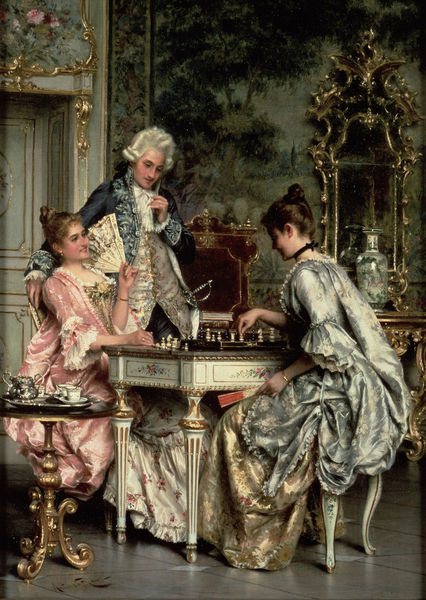
The current misunderstanding of nobility and the analogous traditional elites results largely from the adroit but biased propaganda spread against them by the French Revolution. Such propaganda, continuously disseminated throughout the nineteenth and twentieth centuries by ideological and political currents spawned by the French Revolution, has been challenged by serious historiography with growing efficacy. This propaganda, however, still clings to life in certain sectors of opinion. It is relevant, therefore, to say something about this.
According to the revolutionaries of 1789, the nobility was essentially constituted of pleasure seekers. Holding honorific and economic privileges, the nobles allegedly lived extravagantly off the merit and credit acquired by distant ancestors. This allowed them the luxury of enjoying earthly life, especially the delights of idleness and voluptuousness. This class of pleasure seekers was also highly burdensome to the nation and harmful to the poorer classes, which were hard-working, temperate, and beneficial to the common good. According to d’Argenson, “La Cour était le tombeau de la nation” (the Court was the nation’s tomb).
This led to the notion that the life of a noble, with the station and wealth that normally accompany it, induces a moral negligence that sharply contrasts with Christian asceticism. This perception contains some measure of truth. The first signs of the terrible moral crisis of our day were already visible among the nobility and the analogous elites of the late eighteenth century. It is necessary, however, to stress that this perception is much more false than true and is harmful to the good reputation of the noble class.
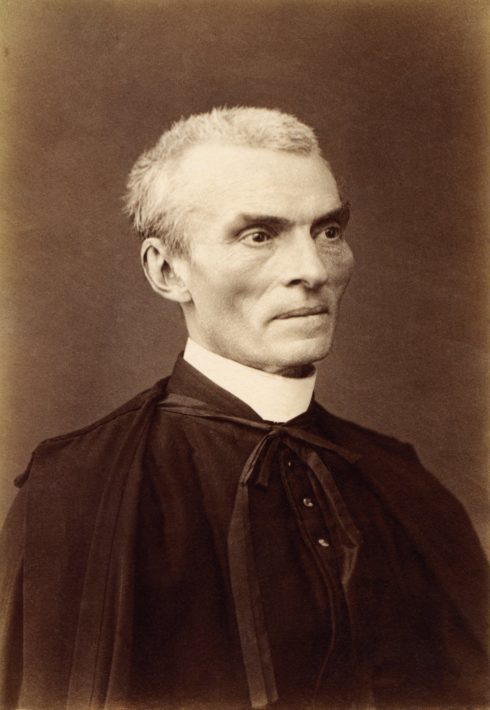
Saint Peter Julian Eymard has noted that “the Church annals show that a large number of saints, and the most illustrious ones, had a blazon, a name, an illustrious family; some were even of royal blood”
Many aspects of the Church’s history prove this, including the fact that she has raised a great number of nobles to the honors of the altar. She thus affirms that they followed the Commandments and the evangelical counsels to a heroic degree.
Saint Peter Julian Eymard has noted that “the Church annals show that a large number of saints, and the most illustrious ones, had a blazon, a name, an illustrious family; some were even of royal blood” (1). While several of these saints abandoned the world to more securely attain heroic virtue, others, such as the kings Saint Louis of France and Saint Ferdinand of Castile, remained amid the splendor of their lofty noble stations and therein attained heroic virtue.
To complete the refutation of this perception, which seeks to degrade the nobility, its customs and lifestyles, we thought it advisable to enquire about the proportion of nobles who were canonized by the Church.
A specific study on this subject could not be found. Some investigators have broached the subject without undertaking specific and exhaustive research. They based their calculations on registers that they themselves present as incomplete. University of Rouen professor André Vauchez published a study, La Sainteté en l’Occident aux Dernieres Siècles du Moyen Age (2), based on the processes of canonization and on medieval hagiographic documents, that merits particular attention. He analyzes the investigations de vita, miraculis et fama ordered by popes between 1198 and 1431. Of a total of 71 investigations, 35 concluded that the persons examined deserved to be elevated to the honors of the altar, which the Church did in the Middle Ages.(3)
The statistics furnished by Vauchez follow:
Processes of canonization ordered between 1198 and 1431
(71 cases)
Nobles 62.0%
Middle Class 15.5%
People 8.4%
Social origin unknown 14.1%
Saints canonized by Popes of the Middle Ages (35 cases)
Nobles 60.0%
Middle Class 17.1%
People 8.6%
Social origin unknown 14.3%
Even if very interesting, this data does not offer a complete picture, since it relates to a very small number of people and to a relatively short period. An investigation encompassing a larger number of people over a longer period was necessary—not that it would exhaust the subject. Nevertheless, some weighty difficulties arose.
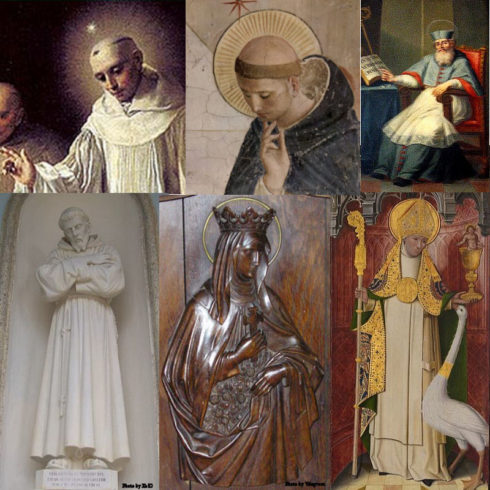
Some of the Noble Saints Canonized between 1198 and 1431; Top, L to R: St. Robert of Molesme, St. Dominic de Guzmán, St. Lawrence O’Toole. Bottom Row: St. Francis of Assisi, St. Elisabeth of Hungary & St. Hugh of Lincoln
First, there is no official list of the saints venerated in the Catholic Church. This is explicable and is related to the very history of the Church and the gradual perfecting of Her institutions. The veneration of saints had its start in the Catholic Church with the homage paid to the martyrs. Local communities honored some of their members who were victims of persecutions. Of the thousands of those who shed their blood in testimony of the Faith in the first centuries of the Church, only a few hundred names have come down to us. We know them through the acts of the Roman tribunals, which transcribed the oral processes, and through reports made by eye-witnesses of the martyrdoms. Many records of the martyrs were simply lacking. Of those that had existed—whose reading inflamed the souls of the first Christians and gave them the strength to bear new tribulations—many were destroyed during the persecutions, especially that of Diocletian.(4) Thus it is impossible to know all the martyrs venerated by the faithful in the first centuries.
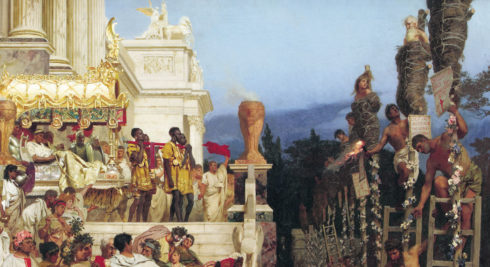
During the persecution of the early martyrs, one of the delights of Nero was to make the Christians into human torches, so his garden would be lit up at night.
After the persecutions, and for a long time, saints were venerated by restricted groups of faithful without prior investigation and pronouncement of an ecclesiastical authority. As the authority’s participation in the organization of the Catholic communities grew, its role in deciding who should receive veneration also grew. The bishops began to sanction this or that cultus, and often ratified it at the request of the faithful. They even made the exhumation and translation of a new saint’s relics.
Only at the end of the first millennium did the popes begin to intervene occasionally in the official recognition of a saint. As the Roman Pontiff’s power was affirmed and the contacts with Rome became more frequent, the bishops began to solicit the pope’s sanction of these cults. This occurred for the first time in 993. Between 993 and 1234 many bishops continued to translate relics and to confirm cults according to the ancient customs. Later, recourse to the Holy See was made compulsory by the 1234 Decretals, and the right of canonization was reserved to the Pontiff. From 1234 on, the processes for determining the veneration of a saint were gradually perfected.
From the end of the thirteenth century, the pontifical decisions were based on a prior investigation carried out by a college of three cardinals especially entrusted with this task. This remained the case until 1588, when the causes were confided to the Congregation of Rites, established the previous year by Pope Sixtus V. In the seventeenth century this development reached its term. In 1634, Urban VIII’s brief Coelestis Jerusalem cives established the standards for canonization, which remain essentially the same to our day. The Constitutions of Urban VIII established the confirmation of cult, or equipollent canonization, for those servants of God whose public veneration had been tolerated after the pontificate of Alexander III (1159-1181). An equipollent canonization is a “decision by which the Sovereign Pontiff orders that a servant of God who is found in public venerations from time immemorial be honored in the Universal Church even though a regular process has not been introduced.”(5) This procedure was valid also for similar cases occurring after the Constitutions of Urban VIII.
Only with the beginning of the sixteenth century can one be certain that the list of saints and blessed (a distinction established by the legislation of Urban VIII) is complete.(6)
Apart from the difficulty in compiling a complete list of the saints, there is the problem of determining who among them belonged to the nobility. The certainty of a person’s noble origin is not always easy to establish. On the one hand, the concept of nobility developed progressively and organically, conditioned by local characteristics. On the other hand, it is sometimes difficult to determine with precision the ancestry of a person, and thus to determine the social origin of a saint.
Having these difficulties in mind, we had to choose the most complete and trustworthy sources possible in order to determine the approximate number of nobles among the saints. The Index ac Status Causorum (7) was chosen because it is an “extraordinary and most ample edition” made to commemorate the fourth centennial of the Congregation and “contains all the causes that came before the Congregation from 1588 to 1988, even the rather ancient ones preserved in the Vatican’s Secret Archives.”
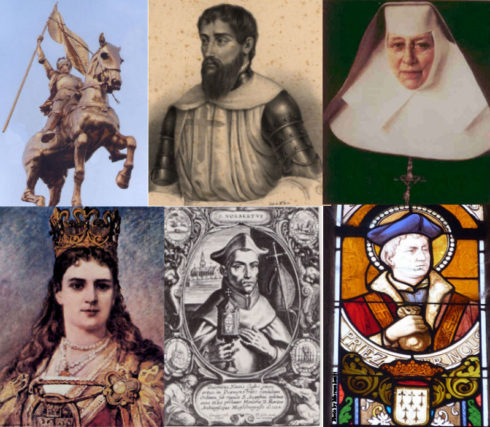
Top row, L to R: St. Joan of Arc, St. Nuno Álvares Pereira, St. Katherine Drexel. Bottom Row: St. Jadwiga of Poland, St. Norbert of Xanten & St. Ivo of Kermartin (also called St. Yves).
The work includes several appendices of which three are of special interest to this study. The first contains confirmations of veneration, some names of the blessed that were added, and those that were removed but later included in the catalogue of the saints. This appendix is based on the Index ac Status Causorum written by Father Beaudoin in 1975. The second appendix enumerates only those beatified since the institution of the Sacred Congregation of Rites but still not canonized. Lastly, the third appendix enumerates the saints whose causes were considered by the Sacred Congregation of Rites, including the cases of equipollent canonization.
With this list of names in hand, we consulted the respective biographies in the Bibliotheca Sanctorum (8) to discover which saints were nobles. This work, supervised by Pietro Cardinal Palazzini, former prefect of the Congregation for the Causes of the Saints, is considered the most complete catalogue of persons who have received veneration since the beginning of the Church.
The Bibliotheca Sanctorum does not focus its principal attention on the social origin of the listed persons, but rather on the problems related to their veneration. Thus, it is frequently impossible to know who was noble. To follow a strict criterion, we counted as nobles only those whom the work identifies as nobles or descendants thereof. Those whom the text merely depicts as belonging to “important,” “known,” “old,” “powerful,” or similarly-designated families were not included. In order to avoid doubtful cases, we further excluded persons who noble origin could reasonably be presumed or even established with certainty through sources other than the Bibliotheca Sanctorum.
For yet greater precision, it also seemed convenient to distinguish the following categories, in accord with the Index ac Status Causorum:
- Saints canonized after a regular process;
- Those beatified after a regular process;
- Those whose venerability was confirmed;
- Servants of God whose processes of beatification are under way.
In the percentages presented in the table which follows, care was taken to discriminate, in each category, between those who were the object of an individual investigation and those who were part of a group, such as, for example, the Japanese, English, and Vietnamese martyrs.(9)
To correctly assess the appreciable percentage of nobles in these various categories, we must consider the percentage of nobles in relation to their respective country’s population. We limit ourselves to two quite diverse and significant examples. According the renowned Austrian historian J. B. Weiss, who drew on Taine’s data, the nobility in France before the French Revolution comprised less than 1.5% of the population.(10) In his treatise on universal geography, La Terra,(11) G. Marinelli furnishes statistics on the nobility in Russia, basing himself on the work of Peschel-Krümel, Das Russische Reich (Leipzig, 1880). According to Marinelli, the sum of the hereditary nobility and personal nobility did not exceed 1.15% of the population. He also states that Rèclus, in 1879, and van Lëhen, in 1881, presented similar statistics, both arriving at the figure of 1.3%. Obviously these percentages varied slightly depending on time and place, but the variations are not significant.
| CANONIZATIONS | Total Number of persons | Number of Nobles | % |
| Individual Processes | 184 | 40 | 21.7 |
| Collective Processes | 364 | 12 | 3.3 |
| Total | 548 | 52 | 9.5 |
| BEATIFICATIONS | |||
| Individual Processes | 182 | 22 | 12.1 |
| Collective Processes | 1074 | 46 | 4.3 |
| Total | 1256 | 68 | 5.4 |
| CONFIRMATIONS | |||
| OF CULTUS | |||
| Individual Processes | 336 | 107 | 31.8 |
| Collective Processes | 1087 | 10 | 0.9 |
| Total | 1423 | 117 | 8.2 |
| BEATIFICATION | |||
| PROCESSES UNDERWAY | |||
| Individual Processes | 1331 | 149 | 11.2 |
| Collective Processes | 2671 | 13 | 0.5 |
| Total | 4002 | 162 | 4.0 |
The data presented above shows that in each of the categories (canonizations, beatifications, confirmations of cultus, and beatification processes underway) the percentage of nobles is considerably greater than in the total population of the country.(12) This contradicts the revolutionary calumnies about the supposed incompatibility between practicing virtue and being and living as a noble.
Footnotes:
(1) Mois de Saint Joseph, p. 62.
(2) André Vauchez, La Sainteté en l’Occident aux Derniers Siècles du Moyen Age (Rome: Ecole Française de Rome, Palais Farnese, 1981), 765 pp.
(3) Several others were canonized later.
(4) Cf. Daniel Ruiz Bueno, Actas de los Martires (Madrid: Biblioteca de Autores Cristianos, 1951).
(5) T. Ortolan, “Canonisation,” in Dictionnaire de Théologie Catholique (Paris: Letouzey et Ané, 1923), Vol. 2, part 2, col. 1636.
(6) Cf. André Vauchez, La Sainteté en l’Occident; John F. Broderick, S.J., “A Census of the Saints (993-1955),” The American Ecclesiastical Review, August 1956; Pierre Delooz, Sociologie et Canonisations (La Haye: Martinus Nijhoff, 1969); Ruiz Bueno, Actas de los Martires; Archives de Sociologie des Religions, published by the Group of Sociology of the Religions (Paris: Editions du Centre National de la Recherche Scientifique, January-June 1962).
(7) Città del Vaticano: Congregatio pro Causis Sanctorum, 1988, 556 pp.
(8) John XIII Institute of the Pontifical Lateran University, 12 vols., 1960-1970; Appendix, 1987.
(9) The Index ac Status Causarum does not have the precise number of persons considered in some of these group processes, thus making it impossible to give an exact number. Our figures are, therefore, approximate.
(10) Weiss, Historia Universal, Vol. 15, p. 212.
(11) G. Marinelli, La Terra—Trattato popolare di Geografia Universale (Milan: Casa Editrice Francesco Vallardi), 7 vols.
(12) We notice, in the several categories, an appreciable difference between the percentage of nobles in the individual processes of beatification and in the collective processes. This can be explained by two main reasons. In many cases, the Biblioteca Sanctorum only mentions the names without furnishing the biographical data that would permit one to know if they were nobles or not. Also, most of the collective processes refer to groups of martyrs. Persecutions are usually directed against the whole Catholic population, regardless of social class. Thus, it is to be expected that among the martyrs the proportion of nobles would be similar to that within the population.
Plinio Corrêa de Oliveira, Nobility and Analogous Traditional Elites in the Allocutions of Pius XII: A Theme Illuminating American Social History (York, Penn.: The American Society for the Defense of Tradition, Family, and Property, 1993), Documents XII, pp. 519-523.
____________________________________
Some noble saints to remember on All Saints Day:
October 31 – He forced the devil to build a church
October 27 – This Christian King Invaded Arabia
October 28 – Saint, Soldier, Statesman
October 25 – Crispin Crispian shall ne’er go by, but we in it shall be remember’d
October 21 – The Tale of Saint Ursula
October 21 – Blessed Karl, Emperor of Austria
October 19 – This Earl was found guilty of praying, and starved to death in the Tower
October 19 – Barefoot from Spain to Rome
October 13 – His reign was one of almost unbroken peace
October 11 – Model Archduke, both spiritual and temporal
October 10 – This man is proof that God can take good out of evil
October 6 – Princes and popes coveted the advice of this silent man
October 4 – You Want Chivalry? A More Heavenly Chivalry? Try This.
October 3 – What does a pious soldier do after a difficult assignment?
September 30 – The cantankerous noble who became a saint
September 29 – In battle or in prison, he never missed Mass
September 27 – These exemplary nobles personified virtue
September 23 – He ensured the immunity of non-combatants in warfare
September 20 – Court preacher to Charles V
September 19 – She begged to ransom Christian captives
September 16 – The pope who exacted tribute from the Mohammedan ruler of Tunis
September 15 – The noble apostle of purgatory
September 8 – The Blessed Virgin Mary descended from King David
September 7 – Grandson of Queen St. Clotilda
September 5 – Unashamed to beg alms from his family
September 2-3 – The September Martyrs of the French Revolution, Blessed John du Lau and Companions
August 30 – She smuggled a priest out of prison
August 30 – Saved by the cross
August 26 – This noblewoman survived the Terror and founded the Daughters of the Cross
August 25 – The King who would rather die than sin
August 25 – King Crusader Saint
August 24 – Chancellor of the court
August 23: He brought peace to Italy’s war-torn city-states in the Middle Ages
August 21 – He was one of a network of aristocrat bishops
August 20 – Saint Philibert of Jumièges
August 20 – The Knights Templar owe him
August 19 – The prince who was made bishop at age 22
August 18 – The Empress who lead the search for the True Cross
August 17 – Her great beauty aroused the jealousy of the queen
August 16 – Apostle of the North
August 16 – His nobles and subjects mourned him for three years
August 13 – The Ottomans lived in fear of this Capuchin
August 12 – His pontificate was spent in opposing royal absolutism
August 12 – St. Jane Frances de Chantal
August 10 – His sister founded the Conceptionists
August 7-8 St. Dominic and St. Cajetan
August 6 – He told his assassins “God does not die!”
August 1 – From impoverished Neapolitan nobility to Doctor of the Church
July 31 – Militant Means Something
July 27 – Wanted: Noble Men for the Missions, Never to Return Home
July 23 – St. Bridget of Sweden
July 20 – Carolingian Reformer
July 19 – Her whole family became saints
July 18 – “Don’t drink water, drink beer” said the bishop
July 17 – Martyred in the Name of Equality
July 14 – The Lily of the Mohawks
July 11 – The noble saint who fled the world, but the world ran after him
July 10 – Seven Holy Noble Brethren
July 10 – Charlemagne Was Stricken for His Rudeness to Her
July 6 – The King Had Three Daughters, All Saints
July 4 – Patroness of victims of adultery, jealousy and unfaithfulness
July 2 – Caught Between Two Masters
June 30 – How the New York Upper Class Was Transformed by One Humble Servant
June 27 – The Saint-King elected to lead the First Crusade
June 26 – Chartreuse is not only a drink
June 22 – He Confronted the Mandate
June 19 – His father the Duke was a murderer
June 19 – Love Accepts No Limitations
June 16 – Death threats meant nothing to him
June 15 – St. Bernard dogs carry his name
June 13 – He Died Aged 36, But the Whole World Knows Him
June 12 – He Crowned Charlemagne
June 8 – Accused of theft and sexual misconduct
June 5 – My God Stands Stronger Than Yours
June 5 – It is in adversity that we test friendship
June 1 – This Aristocrat Gave His Life for the Poor
The death of Saint Ferdinand III, the very noble King of Castile and Leon
May 28 – Upstairs, Downstairs, Ever Steady
May 25 – She withstood the devil
May 22 – Hanged for Publishing
May 19 – Charlemagne’s Scholar
May 19 – He Grabbed the Devil By the Nose
May 16 – Crusader King and Leper
May 15 – Beautiful Princess, Tragic Story
May 12 – Would you accept the crowns of England, France and the Holy Roman Empire? She said no
May 10 – Saint Damien: A Hero Who Died on the Battlefield of Honor
May 8 – Matriarch of the Carolingian familyMay 11 – Holy Merovingian
May 6 – Prince, priest, pioneer
May 4 – They believed in the religious exemption, but only at first
May 3 – Sword-bearer to the Emperor
May 2 – Two sisters of this medieval princess were also saints
April 27 – Noble Model of Confidence
April 23 – The Original Knight in Shining Armor
April 19 – As pope, he led his army against the Normans
April 17 – The Cistercian Founder and Its Orders of Chivalry
April 17 – One of the many nobles who spread the Cluny reform
April 14 – She suffered for the moral corruption and decay of her time
April 13 – The Prince Who Defied His Family
April 9 – She persuaded her husband the Count to become a monk
April 4 – Mother of the Templars
April 3 – Collected the Crusader tax because he was honest with the money of others
April 1 – Noble and Holy Constable
March 29 – “I have fought for God and king, and it is for them that I am going to die”
March 28 – Grandson of King Clovis
St. Louis IX in the exercise of justice
March 22 – He fought with rosary in one hand and sword in the other
March 20 – Homeless Noble Poet
March 19 – Jesus, Mary and Joseph Were Born of Royal Stock
March 17 – St. Patrick the Patrician
March 16 – Chancellor to Italy and Germany
March 15 – The Angels of the Battlefield call her foundress
March 14 – Patroness of Those Falsely Accused
March 13 – Money Cannot Provide Happiness
March 9 – This Nun Was Expert in War
March 9 – She Could Detect Diabolical Plots
March 6 – Prime Minister Bishop
March 6 – Of Kings and Princesses
March 2 – Warrior Bishop Prince
March 2 – This Princess Refused to Marry the Emperor
February 28 – She Married a Man to Change Him and It Worked
February 27 – Are You Hiding a Priest?
February 25 – Princess, Abbess, Miracle Worker
February 24 – Drink the Bitter Cup
February 24 – First Christian King Among the English
February 21 – He Fearlessly Denounced Homosexual Clergy
February 21 – Terror of the Wicked, Supporter of the Weak
February 21 – Shakespeare’s Martyr Muse
February 17 – Marvelous Apparition of Our Lady To Seven Young Nobles
February 14 – Renounced Earthly Nobility To Obtain Heavenly Nobility
February 13 – Mystic and Counselor to Future Popes
February 10 – God Gave Her What Her Brother Would Not
February 9 – Banished From the Court
February 7 – Liberal to Anti-liberal
February 3 – Half Fierce Pagan Princess, Half Gentle Christian Princess
February 3 – The Stuff of Which Saints Are Made
January 31 – The Glory of the Ladies
No Man Has Greater Love Than This
January 24 – Ironmonger Was His Alias
January 17 – She Opposed Her Father the Count
January 13 – Intrepid Reformer
January 13 – The Opponent of Bishop Lucifer
January 13 – The Count Who Converted the King
January 10 – Patient to the Penitent, Inflexible to the Impenitent
Saint Joan of Arc: Enduring Power
January 6 – St. Joan of Arc was born on this day 600 years ago
January 3 – Noble “Archangel of Monks”
January 4 – Nobility in the United States
December 30 – Princess, Orphan, Foundress
December 30 – This Prince Preached Sanctity in Marriage and Chastity in Priesthood
December 29 – Viscount Stafford
December 29 – His Staff Did More Damage Than His Sword
December 27 – Fabiola, Splendor of the Gens Fabia
December 23 – The Knights of Aviz and Their Cistercian Founder
December 23 – He Always Held His Soul in His Hands
December 19 – Tumultuous Times Reveal Noble Souls
December 16 – The Most Important Woman of Her Century
December 16 – Whistleblower Saint
December 13 – Venerated From Time Immemorial
December 13 – The Grandmother of the Marquise de Sévigné
December 9 – The Banker Who Could Recite the Summa
December 6 – Martyr of the Muslims
December 1 – He Hid Priests in His Manorhouse
November 29 – His Grandfather Defeated Charles Martel in Battle
November 25 – She Defied the Emperor
November 22 – The Eternal Glory of the Caecilia Family
November 18 – He Started the Cluniac Reform
November 17 – This Queen Cared for the Sick and Suffering
November 11 – Patron of Veterans and Soldiers
November 10 – First Pope to Be Called “Great”
November 7 – He Went on Crusade to Atone for His Sins
November 4 – Fearless and Faithful, He Reformed the Church

